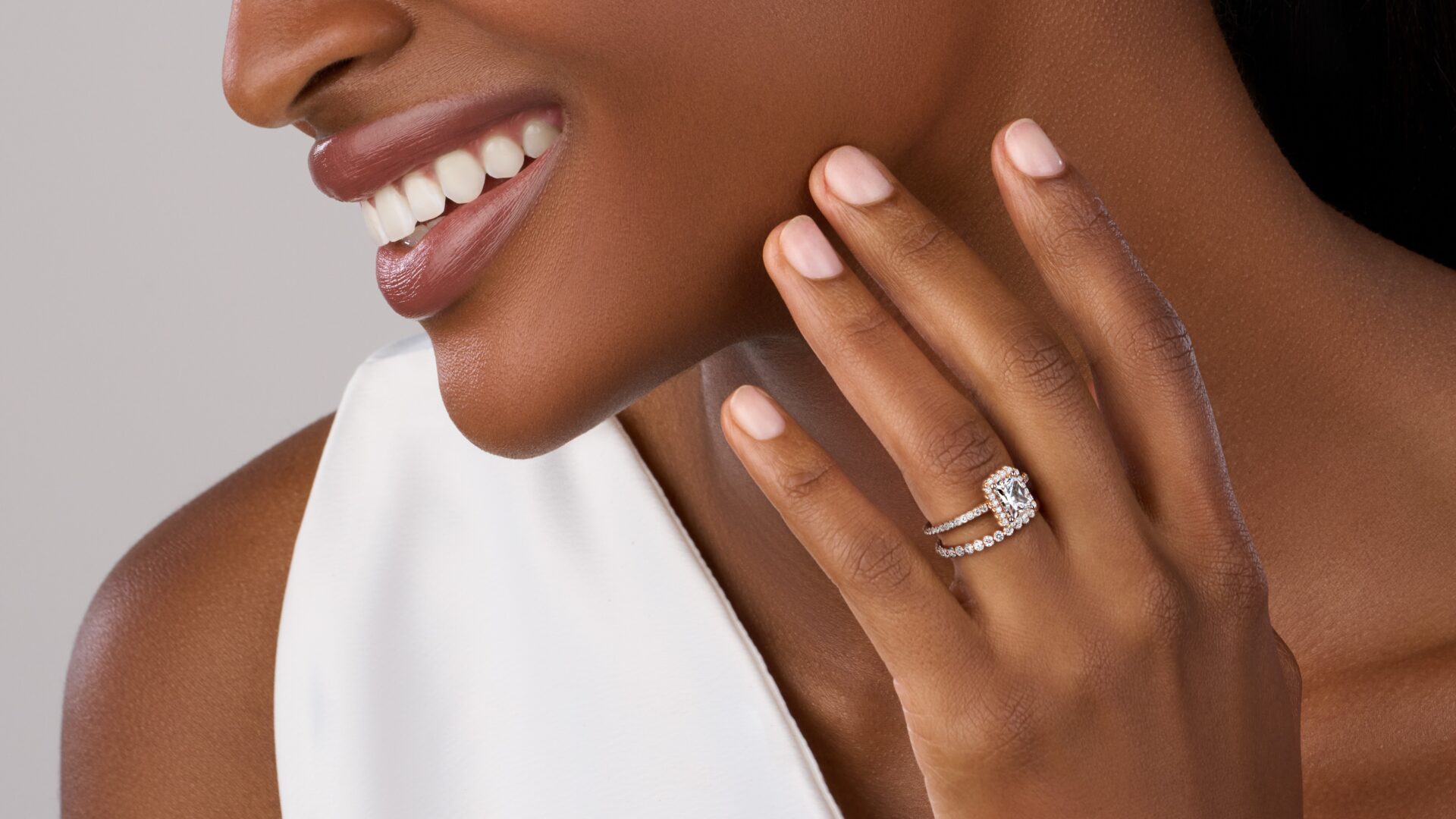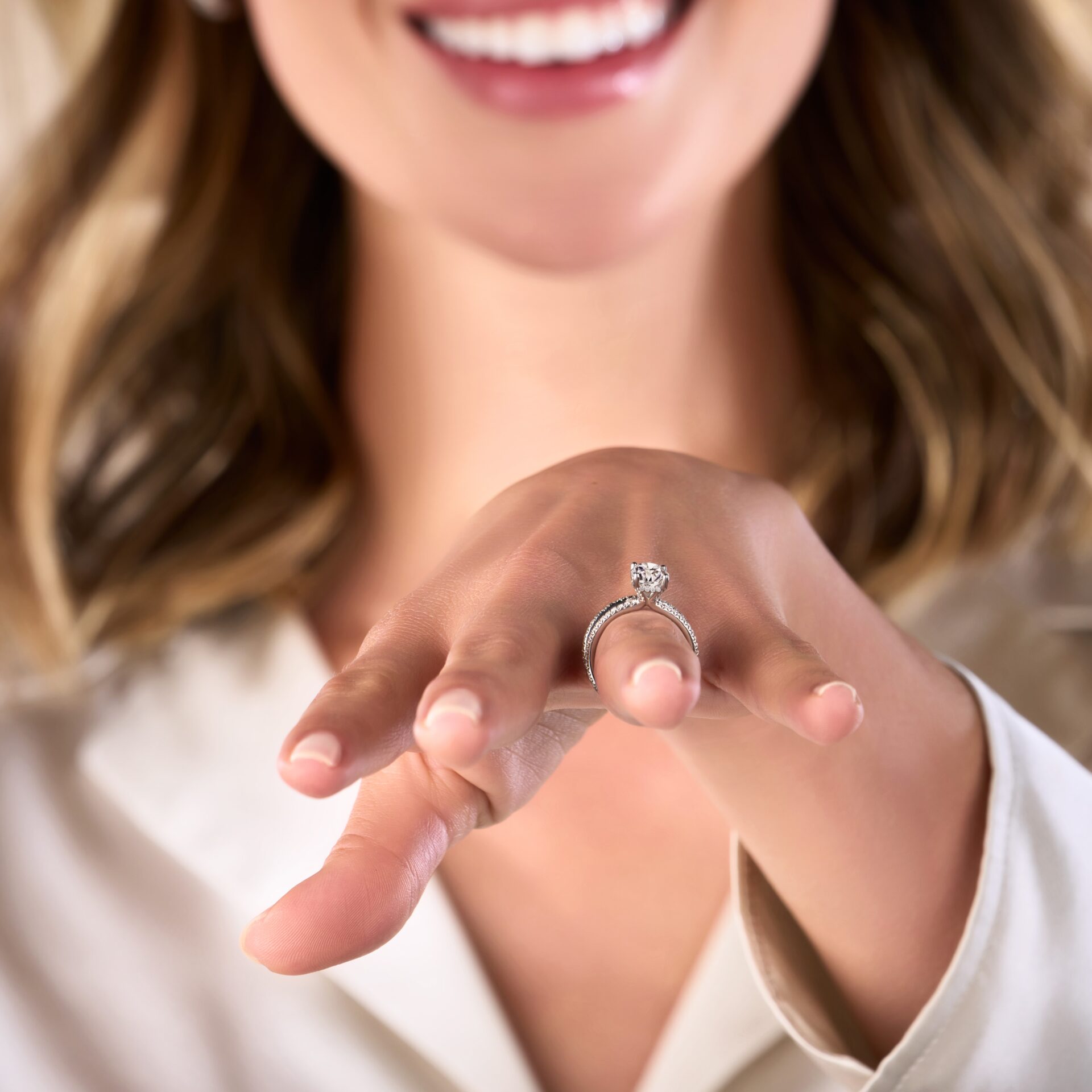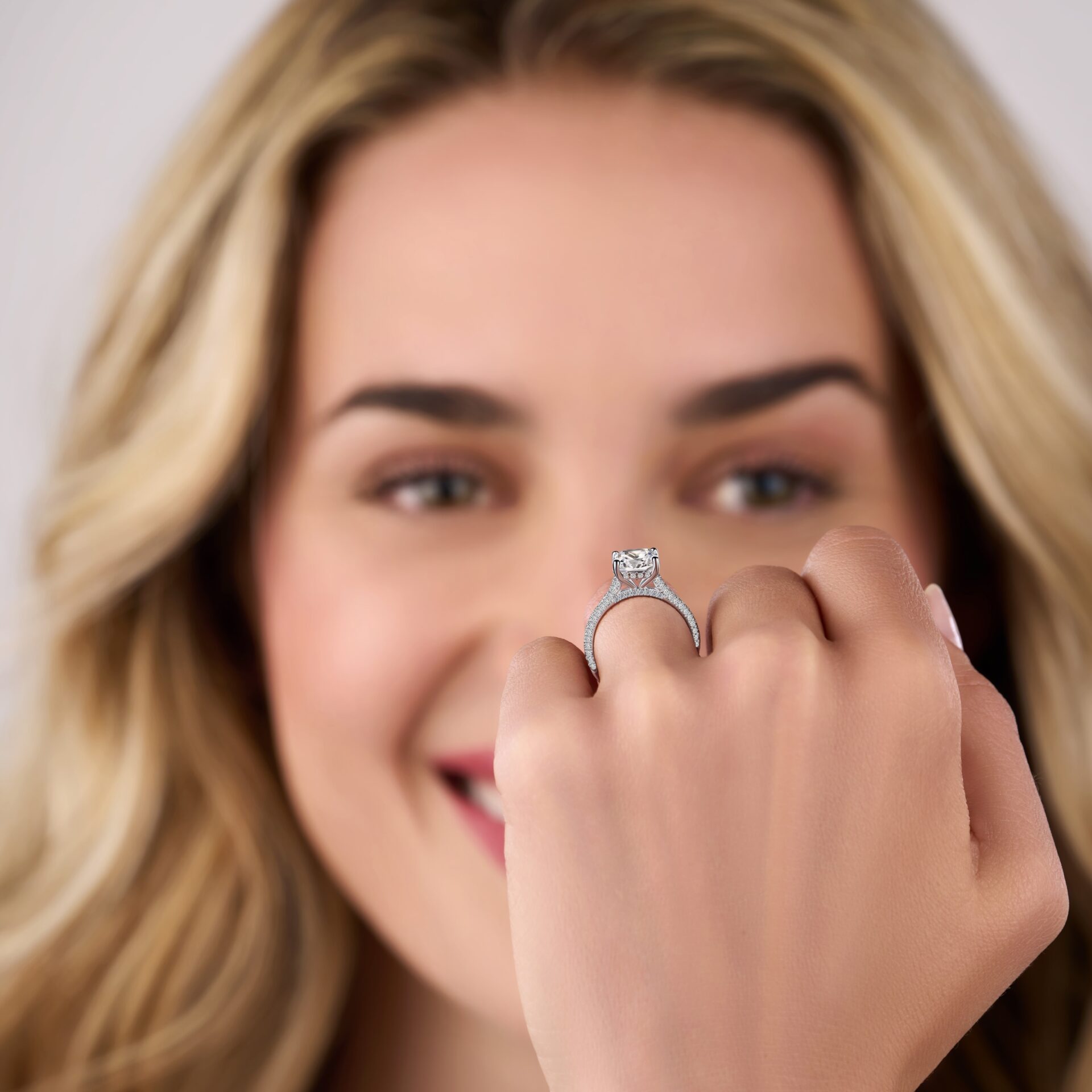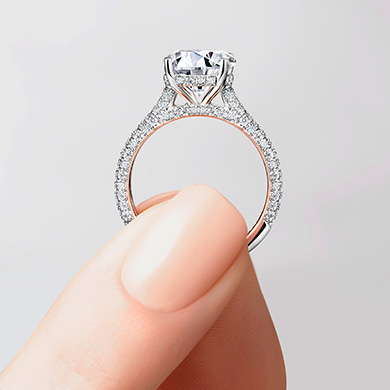Your engagement ring is more than just a piece of jewelry—it symbolizes your love and commitment to your partner. That’s why it’s so important to know how engagement rings fit with proper size. A ring that’s too loose can slip off and get lost, while a ring that’s too tight can be uncomfortable and even lead to health problems. So, how do you know if your engagement ring is the right ring size?
This post will walk you through everything you need about ring sizing and fitting. We’ve covered everything from determining your correct ring size to addressing common fit issues. With our expert tips, you’ll be able to find the perfect engagement ring size that feels as perfect as your love for each other.
How Should an Engagement Ring Fit: Determine the Right Ring Finger Size
Finding the ring size that fits perfectly can be challenging, but several methods can be used to determine the best fit. Here are some of the most common ways that will be helpful about how an engagement ring should fit on your finger:
Professional Ring Sizing:
Visit a professional jeweler at a jewelry store to have your ring finger professionally sized using a ring sizer. This is the most accurate method to ensure rings fit perfectly. A professional jeweler will take your finger shape and other factors into consideration when recommending the perfect size.
Online Ring Sizing Tools:
An online tool to determine your right ring size based on your finger measurements is preferable. A free online conversion chart are also available. Make sure to follow the instructions carefully for accurate results.
The Ribbon Method:
Using a piece of string, ribbon, or measuring tape to measure your ring finger is a simple, inexpensive, and at-home ring sizer option. Wrap the string or ribbon around your finger, mark where it meets, and then measure the length with a ruler or measuring tape. (Ring Sizer Measuring Tool)
Trial Rings:
If you need more clarification on your correct size, consider trying on a few different rings to determine the best fit. This can be especially helpful if you’re buying a ring with a wide band, which can require a larger size.
Ring Sizing Apps:
Numerous mobile apps can help you determine your ring size. These apps use your phone’s camera to measure your particular finger, making it a convenient option for those who prefer a digital solution.
Comfort Fit Rings:
Some jewelers offer comfortable fit rings, which have a slightly larger interior diameter than traditional rings. This can make them more comfortable to wear, but it’s essential to ensure you select the right size to avoid the ring slide past your knuckle, possibly off your finger.
Average Ring Sizes:
You can use average size as a guide if you need clarification how should an engagement ring fit, access to a jeweler or online tool. For example, the average ring size for women is between 6 and 6.5, while the average ring size for men is between 9 and 10.
Trial and Error:
If you’ve tried various methods and aren’t sure of your ring size, you can consider ordering multiple rings in different sizes and returning the ones that don’t fit, This can be time-consuming, but it can be helpful if you’re still unsure of your size.
Factors to Consider When Choosing a Ring Size
When choosing a ring size for your engagement ring, it’s essential to consider various factors to ensure a comfortable and secure fit. Here are some factors to keep in mind:
Ring Style:
The style of engagement ring you choose can also impact the size you need. For example, a ring with a wider band v. a narrow band may require a slightly larger size to ensure a comfortable and secure fit over large knuckles.
The type of metal you choose can also affect the ring size you need. Some metals, like platinum, are denser and heavier, so you may need a slightly larger band size to ensure a correct fit.
Dominant Hand:
If you’re right-handed, your right ring finger may be slightly larger than on your left hand. The opposite is true if you’re left-handed. Consider which hand you’ll wear the ring on and how this may affect the size you need.
Finger Type:
The size and shape of your finger will affect the your engagement ring fit. If you have thicker or wider fingers, you may need a larger ring size to ensure it fits comfortably. Similarly, if you have small fingers, you may need a smaller size to make sure the ring doesn’t easily slide and has a snug fit.
Lifestyle:
Your lifestyle can also impact the size of the perfect ring you want. For example, if you lead an active lifestyle or work with your hands, you may need a slightly larger size to ensure the ring and comfortable during daily activities.
Weather and Climate:
Changes in weather and climate can affect the size of your finger, so it’s essential to consider this when choosing an engagement ring fit. For example, if you live in a hot or humid climate, your fingers swell, so you may need a slightly larger size to ensure a comfortable fit.
Comfort:
Above all, you want to choose the size that feels comfortable on your finger. A ring that is the wrong size can be distracting or uncomfortable to wear, so be sure to try on different sizes to find the perfect fit.
Resizing:
Keep in mind that most rings can be resized if needed. However, if your ring is too big or too small after you’ve received it, feel free to take it to a professional jeweler for resizing.
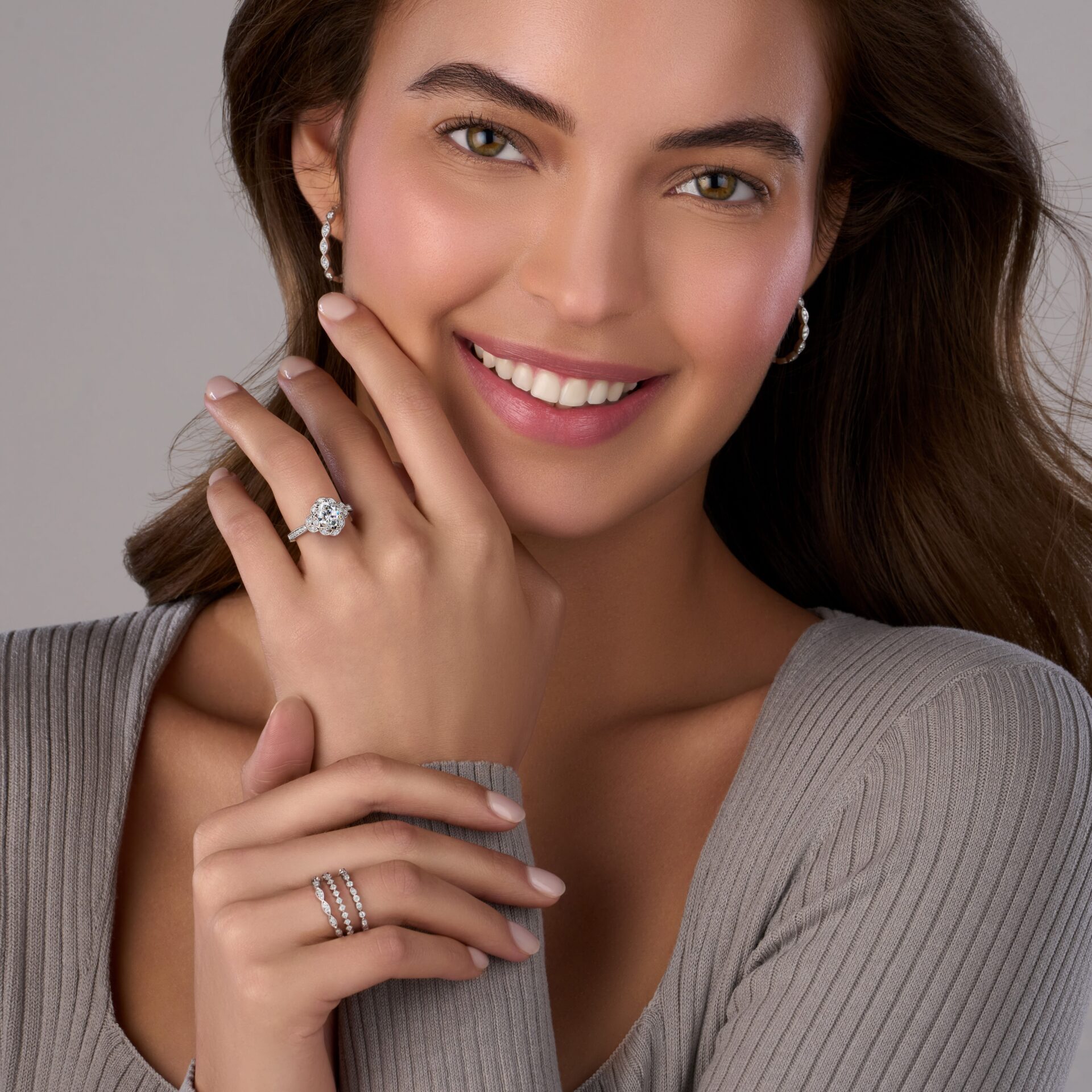
Left Hand: Oval Engagement Ring – Candide in White Gold
Right Hand: Modern Diamond Stackable Band – Laurel in White Gold, White Gold and Diamond Stackable Wedding Band – Madeleina, Delicate Stackable Wedding Band – Eugenie in White Gold
Also Featured: Vintage Inspired Diamond Hoop Earrings in Yellow Gold
How Different Finger Types Affect Engagement Ring Fit
Regarding engagement ring fit, the size of your finger is one of many factors to consider. In addition, different finger types can affect how a ring sits on your finger, including:
Short Fingers: A high profile or wide band ring can make your fingers look even shorter if you have short fingers. Consider a ring with thinner band and an elongated center stone to make your fingers look longer.
Long Fingers: Long fingers can carry a variety of ring styles, but consider a wider band or a ring with multiple smaller stones to fill the space.
Wide Fingers: Wide fingers can benefit from a ring with a wider band or multiple smaller stones, which can help balance the finger and make it appear narrower.
Narrow Fingers: If you have narrow fingers, consider a ring with a thinner band to avoid overwhelming your finger. A solitaire or three-stone ring can also help create the illusion of width.
Swollen Fingers: Swollen fingers can make it difficult to wear a ring, so selecting a comfortable size that won’t cut off circulation is essential. For example, consider a ring with a thinner band or a half-size more significant than your typical size.
Essential Points: How Tight Should an Engagement Ring Fit
The perfect engagement ring fit should feel comfortable and secure on your finger. Here are some key characteristics of a well-fitting engagement ring:
Snug, but not tight: Your engagement ring should give your finger enough room so that it doesn’t cause discomfort or restrict blood flow.
Secure: Your engagement ring should feel confident on your finger without spinning or sliding around. So it should stay in place even if you’re active or moving around.
Comfortable: You should be able to wear your engagement ring for an extended period without experiencing discomfort or irritation. The ring should not feel tight, pinch or dig into your skin, causing discomfort or irritation.
Easy to remove: Your engagement ring should be easy to remove but not so loose that it falls off your finger accidentally. Additionally, ring should not slide up and down your finger, as this can signify that it’s too loose or not in the right shape for your finger.
Even pressure: The ring should fit snugly around your finger without any noticeable gaps or areas of tightness. Also, your engagement ring should align with your other fingers and not feel like it’s sticking out or in the way.
By keeping these characteristics in mind, you may have an idea how an engagement ring should fit perfectly, allowing you to enjoy it every day without any issues.
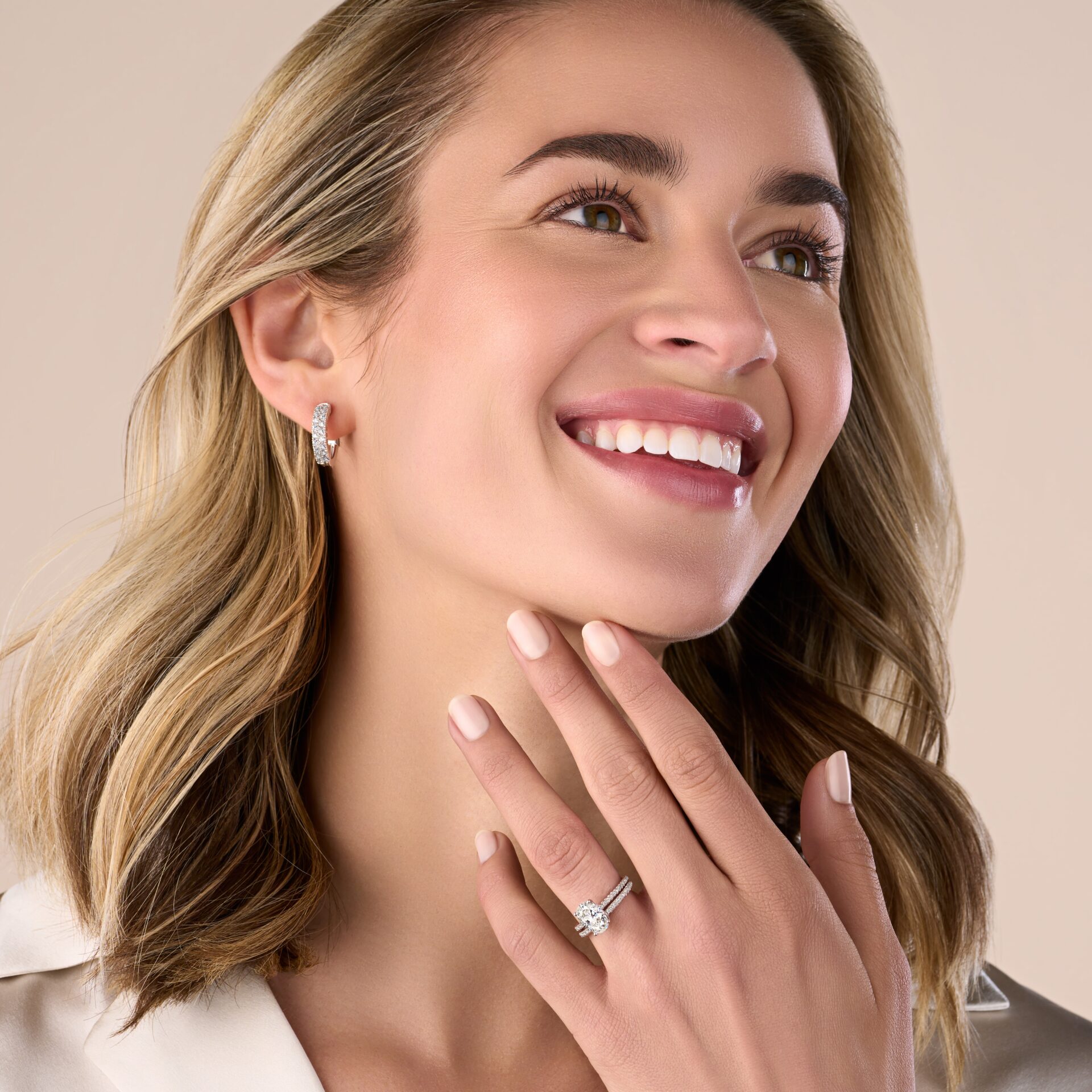
Oval Cut Classic Engagement Ring – Maryam paired with Classic Wedding Band – Maryam in White Gold, also featuring Double Row Diamond Huggies in White Gold
Common Engagement Ring Fit Issues and How to Address Them
Several common issues can arise with an engagement ring fit, even if you’ve measured your ring size accurately. Here’s how to address some of the most common problems:
Ring Spinning: If your ring spins on your finger, it’s likely too big or it could be because of a disproportion of weight between the center stone and the band. To address this issue, consider getting the ring resized or adding sizer balls or a ring guard to the inside of the band.
Tightness: If your ring feels too tight or uncomfortable, it may be too small. To address this issue, try wearing your ring on a different finger than your left ring finger, or consider getting the ring resized.
Swelling: If your fingers fluctuate in size due to temperature or salty foods, your ring may fit snug or feel uncomfortable. In this case, removing the ring is essential to avoid discomfort and potential injury.
Knuckle Fit: If your ring fits over your second knuckle but feels too loose once it’s on the base of your finger, sizing beads can be added to the inside of the band to keep the ring in place.
By addressing these common fit issues, you can ensure your engagement ring fit is comfortable and secure on your finger, allowing you to enjoy it for years to come.
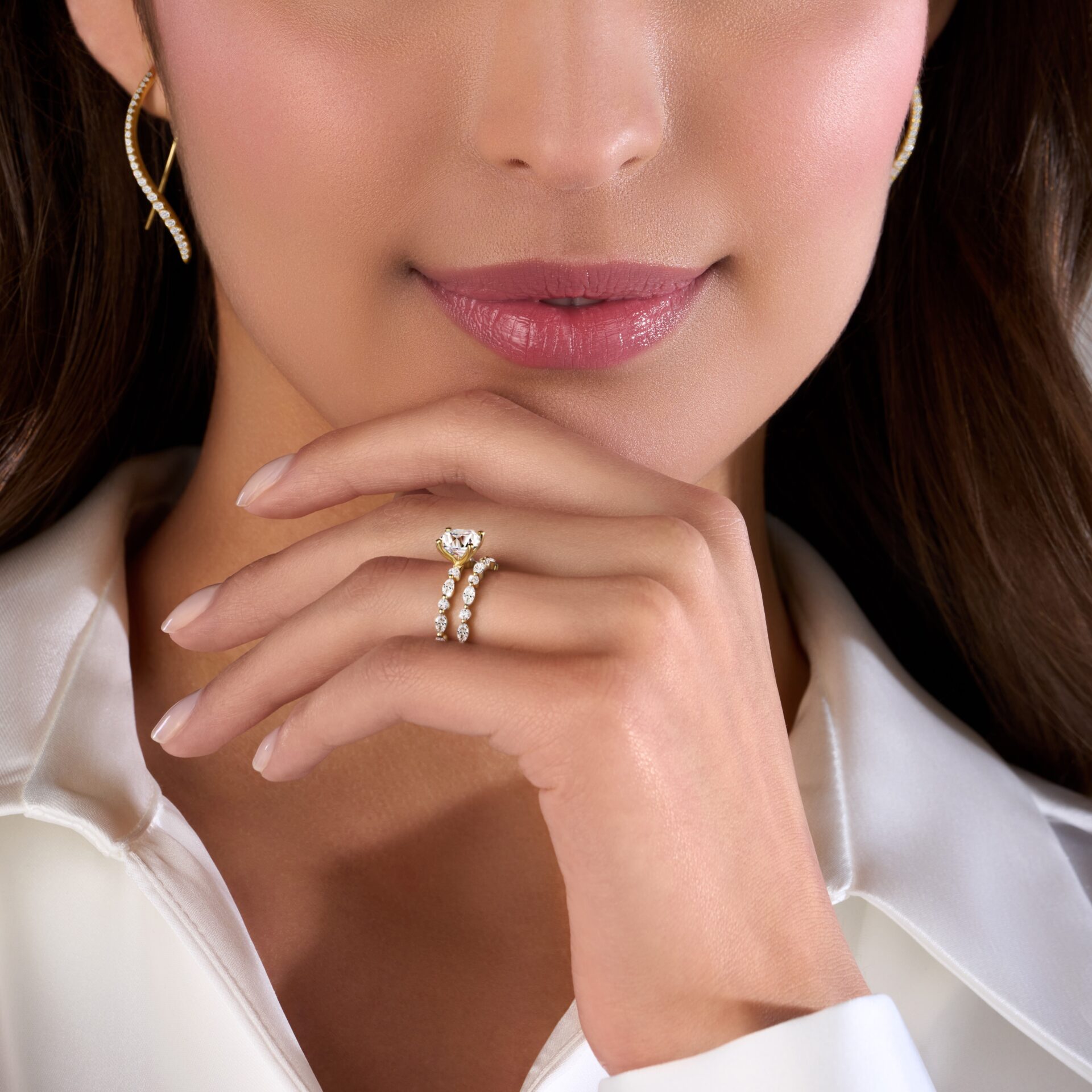
Unique Engagement Ring – Felicity and Stackable Wedding Band in Yellow Gold paired with Diamond Fishook Drop Earrings
Conclusion
In conclusion, finding the perfect engagement ring fit is of the utmost importance to ensuring that you can comfortably wear and showcase this precious piece of jewelry.
It’s essential to consider your finger type and the style of ring you select to ensure that it flatters your hand and feels comfortable to wear. Feel free to work with a trusted jeweler who can guide you and tell you how engagement rings should fit. With the perfect fit, you can enjoy your engagement ring for years to come as a symbol of your love and commitment.
